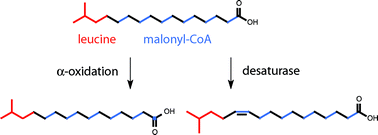Biosynthesis of iso-fatty acids in myxobacteria†
Abstract
The

* Corresponding authors
a
Institut für Organische Chemie, TU Braunschweig, Hagenring 30, 38106 Braunschweig, Germany
E-mail:
stefan.schulz@tu-bs.de
Fax: +49 531 391 5272
Tel: +49 531 391 7353
b Institut für Pharmazeutische Biotechnologie, Universität des Saarlandes, Geb. 8.1, 66123 Saarbrücken, Germany
c Deutsche Sammlung für Zellkulturen und Mikroorganismen (DSZM), Mascheroder Weg 1b, 38124 Braunschweig, Germany
The

 Please wait while we load your content...
Something went wrong. Try again?
Please wait while we load your content...
Something went wrong. Try again?
J. S. Dickschat, H. B. Bode, R. M. Kroppenstedt, R. Müller and S. Schulz, Org. Biomol. Chem., 2005, 3, 2824 DOI: 10.1039/B504889C
To request permission to reproduce material from this article, please go to the Copyright Clearance Center request page.
If you are an author contributing to an RSC publication, you do not need to request permission provided correct acknowledgement is given.
If you are the author of this article, you do not need to request permission to reproduce figures and diagrams provided correct acknowledgement is given. If you want to reproduce the whole article in a third-party publication (excluding your thesis/dissertation for which permission is not required) please go to the Copyright Clearance Center request page.
Read more about how to correctly acknowledge RSC content.
 Fetching data from CrossRef.
Fetching data from CrossRef.
This may take some time to load.
Loading related content
